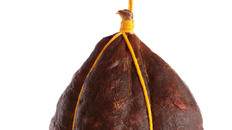Meats and Sausages
Kindziuk
Kindziuk sausage is made from pork and beef is smoked and dried, but not cooked. It may be considered a traditionally fermented product. Kindziuk - known in Poland as Kindziuk and in Lithuania as Skilandis, is an almost legendary product, famous for its long keeping properties.
| Meats | Metric | US |
|---|---|---|
| lean pork | 850 g | 1.87 lb. |
| lean beef | 150 g | 0.33 lb. |
Ingredients per 1000g (1 kg) of meat
| salt | 33 g | 6 ½ tsp. |
| Cure #2 | 2.5 g g | ½ tsp. |
| sugar | 1.0 g | ¼ tsp. |
| pepper | 2.0 g | 1 tsp. |
| herbal pepper* | 1.0 g | ½ tsp. |
| garlic | 3.5 g | 1 clove |
Instructions
- Cut meat into 2” pieces. Rub in salt, Cure # 2 and sugar and leave on a screen for 3-4 days at 3-4° C (37-40° F).
- Cut pork into 20-30 mm (¾-1¼”) by 10-15 mm (3/8-5/8”) pieces.
- Grind beef through 2-3 mm (1/8”) plate.
- Mix beef with all spices. Add pork and mix everything together.
- Stuff firmly into pork stomach, bladder, 60 mm beef middles or 60 mm fibrous casings. Reinforce with butcher’s twine: two loops lengthwise and loops across the casings every 2” (5 cm). Form 10-12 cm (4-5”) hanging loop on one end.
- Hang for 2 months at 2-4° C (35-40° F).
- Apply cold smoke 18-22° C (64-72° F) for 8 hours.
- Hang in a cool place for 2 weeks.
- Apply cold smoke again at 18-22° C (64-72° F) for 8 hours.
- Dry for 2 months at 8° C (46° F) and 75% humidity. The sausage should lose about 35% of its original weight.
- Store in a dark, cool and dry place.
Notes
Meat should come from mature animals. Remove all sinews, glands and gristle.
Originally all ingredients were stuffed into the pork stomach or bladder. The stomach was sewn and the bladder was tied off with butcher twine.
Traditional Kindziuk was smoked with alder wood.
Don’t decrease the amount of salt. Salt and nitrite are the first line of defense against spoilage and pathogenic bacteria. Then as the sausage dries out it becomes more microbiologically stable every day.
* Herbal pepper is a combination of spices which is used in many countries such as French Quatre-epices (pepper, nutmeg, cloves, cinnamon) or Indian curry powder (turmeric, coriander, fenugreek, cumin and other spices). Italian seasoning (marjoram, thyme, rosemary, savory, sage, oregano and basil) is another known combination of herbs. In East European countries such as Poland or Lithuania herbal pepper is commercially made and available in supermarkets. A typical Polish herbal pepper contains: white mustard seed, caraway, marjoram, chili, hot and sweet paprika and bay leaf. You can buy pre-mixed spices or use your imagination for creating your own version. If you decide to go without herbal pepper, use 3 g (1½ tsp) of black or white pepper.


















